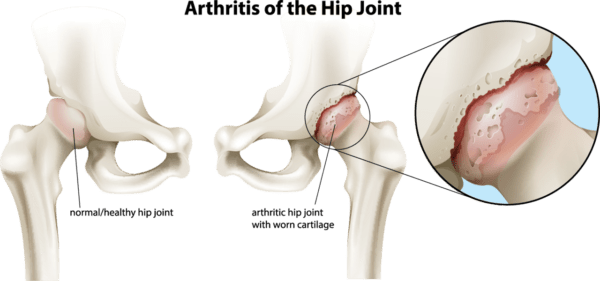Can’t Put on Socks? Why This Could Be a Bad Sign
On this page:
- Hip range of motion and why it’s critical
- Why is it a big deal if you can’t put on socks?
- What if you don’t have much hip pain?
- What do I do if I notice this problem?
I see patients every day who have lost hip range of motion and can’t put on socks anymore. Is this a big deal? Regrettably, few of them know that this likely means their hip joints are getting slowly fried and arthritic. While knees may smolder for years, hips go quick, so a sudden inability to put your socks on may be a colossal deal. Let me explain.
Hip Range of Motion and Why It’s Critical
If there is one finding on physical exam that I see day in and day out that correlates with the development of serious hip arthritis, it’s loss of range of motion. This finding is different from that in the knee, where this kind of range-of-motion loss is rarer and happens slowly. In the hip, it can occur quickly and lead to the rapid onset of arthritis that can become severe within a year or two (1). So the patient can go from having no issues in the hip to needing a hip replacement inside of 24 months.
One of the reasons hip arthritis may come on so quickly and virulently is range-of-motion (ROM) loss. The lack of movement of the hip has the effect of concentrating all of the forces in a limited area. Unlike the knee, which has large joint surfaces and often better preserved ROM, which can dissipate forces over that area, the weight-bearing surfaces of the hip are smaller. So when the contact areas are further limited by poor ROM, these forces may wear away cartilage much faster.

BlueRingMedia/Shutterstock
Why Is It a Big Deal if You Can’t Put On Socks?
To don or doff your socks, you need adequate hip range of motion. If you’re finding it harder and harder to get that foot up on your opposite leg, it could be because of lost hip range of motion. As discussed above, the fact that you can’t put on socks could mean that severe hip arthritis is on its way.
What if You Don’t Have Much Hip Pain?
Since a sudden range-of-motion loss can be a sign of early arthritis that can rapidly progress to its severe form, you may or may not have hip pain yet (2). However, pay attention to lost hip range of motion. This is because going from mild arthritis to a destroyed joint can happen quickly. Besides, new biologic treatments, like an injection of platelets or stem cells, are more likely to work if the disease is caught in its earlier stages.
What Do I Do if I Notice This Problem?
First, insist on getting the hip imaged with an MRI. Many physicians these days won’t want to order an MRI, but instead an X-ray. Why not an X-ray? Because it’s easier to access the quality of the bone on an MRI for things like microfracturing that can lead to dead bone areas called cysts and a rapidly degenerated joint (3).
If you have hip arthritis, if it’s caught early, a platelet rich plasma or stem cell injection may help turn the tide. Also, physical therapy to help regain lost ROM and strength in the joint may be helpful. If that doesn’t work, using injections of platelet growth factors to stretch the tight hip ligaments can help regain the motion.
The upshot? If you’ve recently noticed you can’t put on socks as easily, beware—hip arthritis may be on the way! Make sure you get your hip checked immediately!
__________________________________________________
References
(1) Taljanovic MS, Graham AR, Benjamin JB, et al. Bone marrow edema pattern in advanced hip osteoarthritis: quantitative assessment with magnetic resonance imaging and correlation with clinical examination, radiographic findings, and histopathology. Skeletal Radiol. 2008;37(5):423-431. doi:10.1007/s00256-008-0446-3
(2) Ahedi H, Aitken D, Blizzard L, Cicuttini F, Jones G. A population-based study of the association between hip bone marrow lesions, high cartilage signal, and hip and knee pain. Clin Rheumatol. 2014;33(3):369-376. doi:10.1007/s10067-013-2394-0
(3) Kim C, Nevitt MC, Niu J, et al. Association of hip pain with radiographic evidence of hip osteoarthritis: diagnostic test study. BMJ. 2015;351:h5983. Published 2015 Dec 2. doi:10.1136/bmj.h5983

NOTE: This blog post provides general information to help the reader better understand regenerative medicine, musculoskeletal health, and related subjects. All content provided in this blog, website, or any linked materials, including text, graphics, images, patient profiles, outcomes, and information, are not intended and should not be considered or used as a substitute for medical advice, diagnosis, or treatment. Please always consult with a professional and certified healthcare provider to discuss if a treatment is right for you.
